Global AI in Epidemiology Market: By Deployment Mode, By Application, By End User, By Region & Segmental Insights Trends and Forecast, 2024 – 2034
- Industry: Healthcare
- Report ID: TNR-110-1261
- Number of Pages: 420
- Table/Charts : Yes
- August, 2024
- Base Year : 2024
- No. of Companies : 10+
- No. of Countries : 29
- Views : 10056
- Covid Impact Covered: Yes
- War Impact Covered: Yes
- Formats : PDF, Excel, PPT
Artificial intelligence (AI) has revolutionized numerous industries, and epidemiology is no exception. The AI in epidemiology market is witnessing substantial growth as the demand for more accurate, efficient, and predictive models in disease surveillance, outbreak management, and public health interventions increases. This market is characterized by the integration of AI technologies such as machine learning, natural language processing (NLP), and predictive analytics into epidemiological practices. The rise of global health threats, such as pandemics and chronic diseases, has further accelerated the adoption of AI in epidemiology, driving innovation and investment in this field. The global AI in epidemiology market was worth US$ 0.51 Bn in 2023, anticipated to reach US$ 4.9 Bn by 2034, at a CAGR of 34.2% during 2024 – 2034.
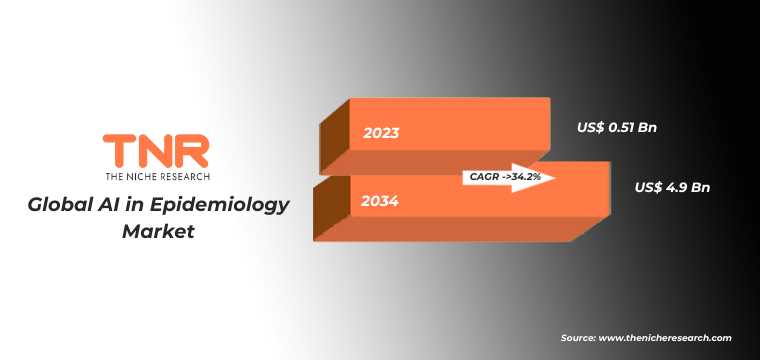
Market Dynamics: Global AI in Epidemiology Market
Growing Need for Real-Time Disease Surveillance: The ongoing threat of infectious diseases, including COVID-19, has underscored the need for real-time disease tracking and monitoring. AI tools are increasingly being used to predict outbreaks, identify disease patterns, and manage public health responses more effectively.
Advancements in AI and Big Data Analytics: Ongoing advancements in AI technologies, especially in machine learning and big data analytics, have significantly enhanced the ability to process large volumes of epidemiological data. These cutting-edge technologies improve decision-making by uncovering trends, identifying risk factors, and predicting potential outbreaks before they happen.
Government Initiatives and Funding: Government bodies and public health organizations worldwide are investing heavily in AI-driven epidemiological tools to enhance public health infrastructure. This investment is expected to drive the growth of the AI in Epidemiology market.
Data Privacy Concerns: The collection and analysis of health data raise significant privacy concerns. Stringent regulations, such as the General Data Protection Regulation (GDPR) in Europe, may pose challenges to the widespread adoption of AI in epidemiology.
Integration with Genomic Data: The integration of AI with genomic data presents a significant opportunity for the AI in epidemiology market. This integration can result in more tailored and precise disease prediction models.
Expansion into Emerging Markets: As emerging economies improve their healthcare infrastructure, there is a growing opportunity for AI in epidemiology. These regions are increasingly adopting AI technologies to manage infectious diseases and improve public health outcomes.
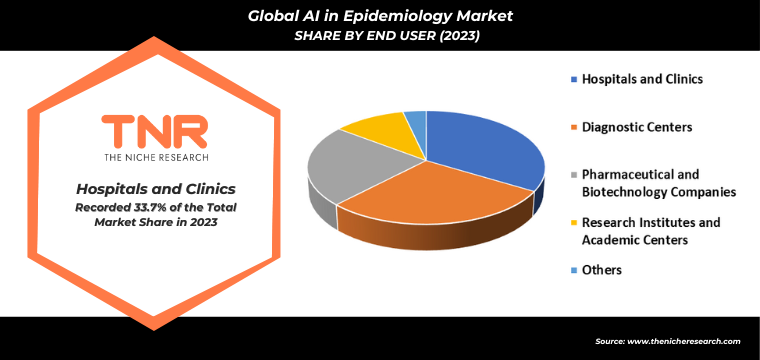
Recent Developments
COVID-19 Impact: The COVID-19 pandemic has augmented the adoption of AI in epidemiology. Numerous AI-driven tools were developed during the pandemic to monitor disease spread, predict outbreaks, and manage public health responses. This trend is expected to continue post-pandemic, driving long-term market growth.
Collaborations and Partnerships: Companies are increasingly collaborating with government agencies, research institutes, and healthcare providers to develop and implement AI-driven epidemiological solutions.
Product Innovations: The AI in epidemiology market is witnessing continuous innovation, with companies developing new AI tools tailored to specific epidemiological needs. For example, AI-driven contact tracing apps, predictive models for future outbreaks, and AI-powered data analytics platforms are gaining traction.
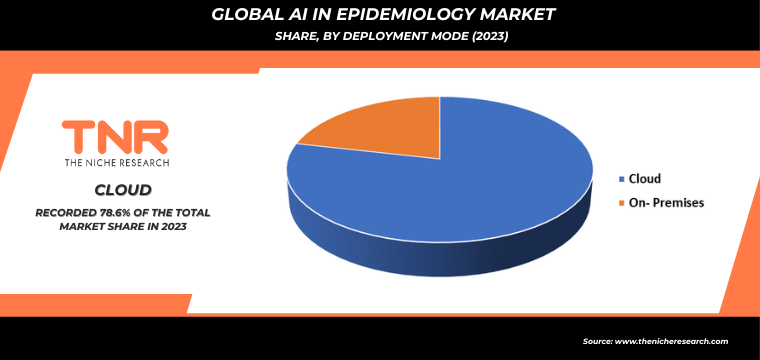
Segmental Insights: Global AI in Epidemiology Market
In 2023, disease surveillance and monitoring emerged as the dominant application area in the AI in epidemiology market, largely due to the increasing demand for real-time monitoring and prediction of disease outbreaks. The global health landscape has been significantly impacted by recent pandemics, which have underscored the critical need for advanced surveillance systems capable of quickly identifying and responding to potential health threats. AI technologies, particularly machine learning and predictive analytics, have been instrumental in enhancing the accuracy and speed of disease monitoring efforts. These technologies enable the analysis of vast datasets, including health records, social media activity, and environmental factors, to detect patterns and predict potential outbreaks before they occur. In addition, outbreak management and public health interventions have also gained prominence as key application areas. The ability to swiftly manage outbreaks and implement targeted public health measures is crucial, especially in the context of global pandemics where rapid response can significantly reduce the spread of disease and save lives. AI-driven tools are increasingly being used to optimize these interventions, making them more effective and efficient. This growing reliance on AI for disease surveillance, monitoring, and management reflects the broader trend towards leveraging advanced technologies to enhance global health security.
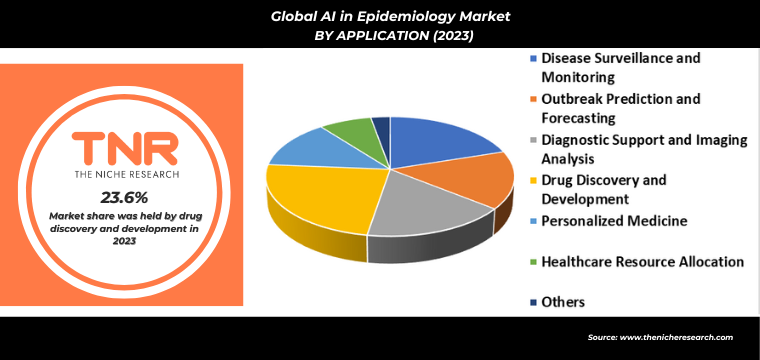
In 2023, Europe emerged as the second-largest region in the AI in Epidemiology market, accounting for approximately 25-30% of the global market share.
This growth was propelled by strong government support, advanced healthcare infrastructure, and a proactive approach to public health. For example, the European Commission’s Horizon Europe program allocated over €95 billion to research and innovation from 2021 to 2027, with a significant portion dedicated to health and AI-driven initiatives. This funding has supported the development and implementation of AI technologies across the region. Germany, for instance, has been a leader in adopting AI for public health, investing in projects like the “PANDEM-2” initiative, which aims to enhance pandemic preparedness through AI-driven disease surveillance. Similarly, the United Kingdom’s National Health Service (NHS) has been leveraging AI for disease monitoring and outbreak prediction, particularly through partnerships with tech companies like DeepMind, which is part of Google Health. These initiatives have enabled Europe to build a resilient public health infrastructure that can respond effectively to emerging health threats.
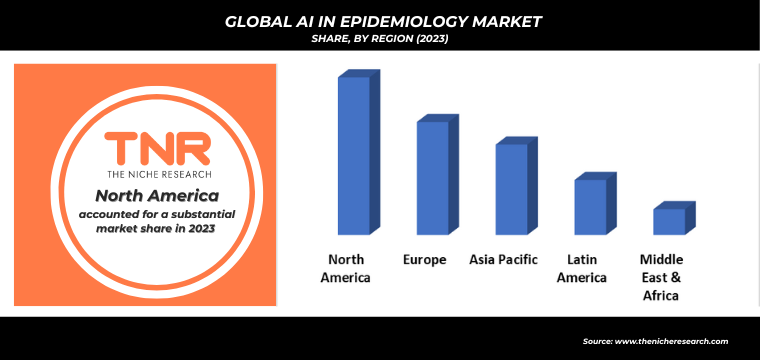
Competitive Insights: Global AI in Epidemiology Market
The AI in epidemiology market is highly competitive, with key players focusing on innovation and strategic collaborations to gain a competitive edge. Key companies operating in the market include:
- Bayer AG
- Cardiolyse
- Cognizant
- eClinical Works Inc
- Epic Systems Corporation
- Intel Corporation
- Komodo Health, Inc.
- Microsoft
- Oracle
- Predixion Software
- SAS Institute Inc.
- Siemens Healthcare Private Limited
- Other Market Participants
Many AI companies are partnering with government agencies, research institutions, and healthcare epidemiology providers to co-develop and deploy AI-driven epidemiological tools. For example, Siemens Healthineers has collaborated with several European governments to integrate AI into their public health surveillance systems, enhancing their ability to monitor and respond to health crises.
Thus, the global AI in epidemiology market is highly competitive, with companies continually investing in research and development to maintain their market positions. The competition is expected to intensify as more players enter the market and as AI technology continues to evolve, offering new capabilities and applications in the field of epidemiology.
Global AI in Epidemiology Market Scope
| Report Specifications | Details |
| Market Revenue in 2023 | US$ 0.51 Bn |
| Market Size Forecast by 2034 | US$ 4.9 Bn |
| Growth Rate (CAGR) | 34.2% |
| Historic Data | 2018 – 2022 |
| Base Year for Estimation | 2023 |
| Forecast Period | 2024 – 2034 |
| Report Inclusions | Market Size & Estimates, Market Dynamics, Competitive Scenario, Trends, Growth Factors, Market Determinants, Key Investment Segmentation, Product/Service/Solutions Benchmarking |
| Segments Covered | By Deployment Mode, By Application, By End User, By Region |
| Regions Covered | North America, Europe, Asia Pacific, Middle East & Africa, Latin America |
| Countries Covered | U.S., Canada, Mexico, Rest of North America, France, The UK, Spain, Germany, Italy, Nordic Countries (Denmark, Finland, Iceland, Sweden, Norway), Benelux Union (Belgium, The Netherlands, Luxembourg), Rest of Europe, China, Japan, India, New Zealand, Australia, South Korea, Southeast Asia (Indonesia, Thailand, Malaysia, Singapore, Rest of Southeast Asia), Rest of Asia Pacific, Saudi Arabia, UAE, Egypt, Kuwait, South Africa, Rest of Middle East & Africa, Brazil, Argentina, Rest of Latin America |
| Key Players | Bayer AG, Cardiolyse, Cognizant, eClinical Works Inc, Epic Systems Corporation, Intel Corporation, Komodo Health, Inc., Microsoft, Oracle, Predixion Software, SAS Institute Inc., Siemens Healthcare Private Limited |
| Customization Scope | Customization allows for the inclusion/modification of content pertaining to geographical regions, countries, and specific market segments. |
| Pricing & Procurement Options | Explore purchase options tailored to your specific research requirements |
| Contact Details | Consult With Our Expert
Japan (Toll-Free): +81 663-386-8111 South Korea (Toll-Free): +82-808- 703-126 Saudi Arabia (Toll-Free): +966 800-850-1643 United Kingdom: +44 753-710-5080 United States: +1 302-232-5106 E-mail: askanexpert@thenicheresearch.com
|
Global AI in Epidemiology Market
By Deployment Mode
- Cloud
- On- Premises
By Application
- Disease Surveillance and Monitoring
- Outbreak Prediction and Forecasting
- Diagnostic Support and Imaging Analysis
- Drug Discovery and Development
- Personalized Medicine
- Healthcare Resource Allocation
- Others
By End User
- Hospitals and Clinics
- Diagnostic Centers
- Pharmaceutical and Biotechnology Companies
- Research Institutes and Academic Centers
- Others
By Region
- North America (U.S., Canada, Mexico, Rest of North America)
- Europe (France, The UK, Spain, Germany, Italy, Nordic Countries (Denmark, Finland, Iceland, Sweden, Norway), Benelux Union (Belgium, The Netherlands, Luxembourg), Rest of Europe)
- Asia Pacific (China, Japan, India, New Zealand, Australia, South Korea, Southeast Asia (Indonesia, Thailand, Malaysia, Singapore, Rest of Southeast Asia), Rest of Asia Pacific)
- Middle East & Africa (Saudi Arabia, UAE, Egypt, Kuwait, South Africa, Rest of Middle East & Africa)
- Latin America (Brazil, Argentina, Rest of Latin America)
Report Layout:
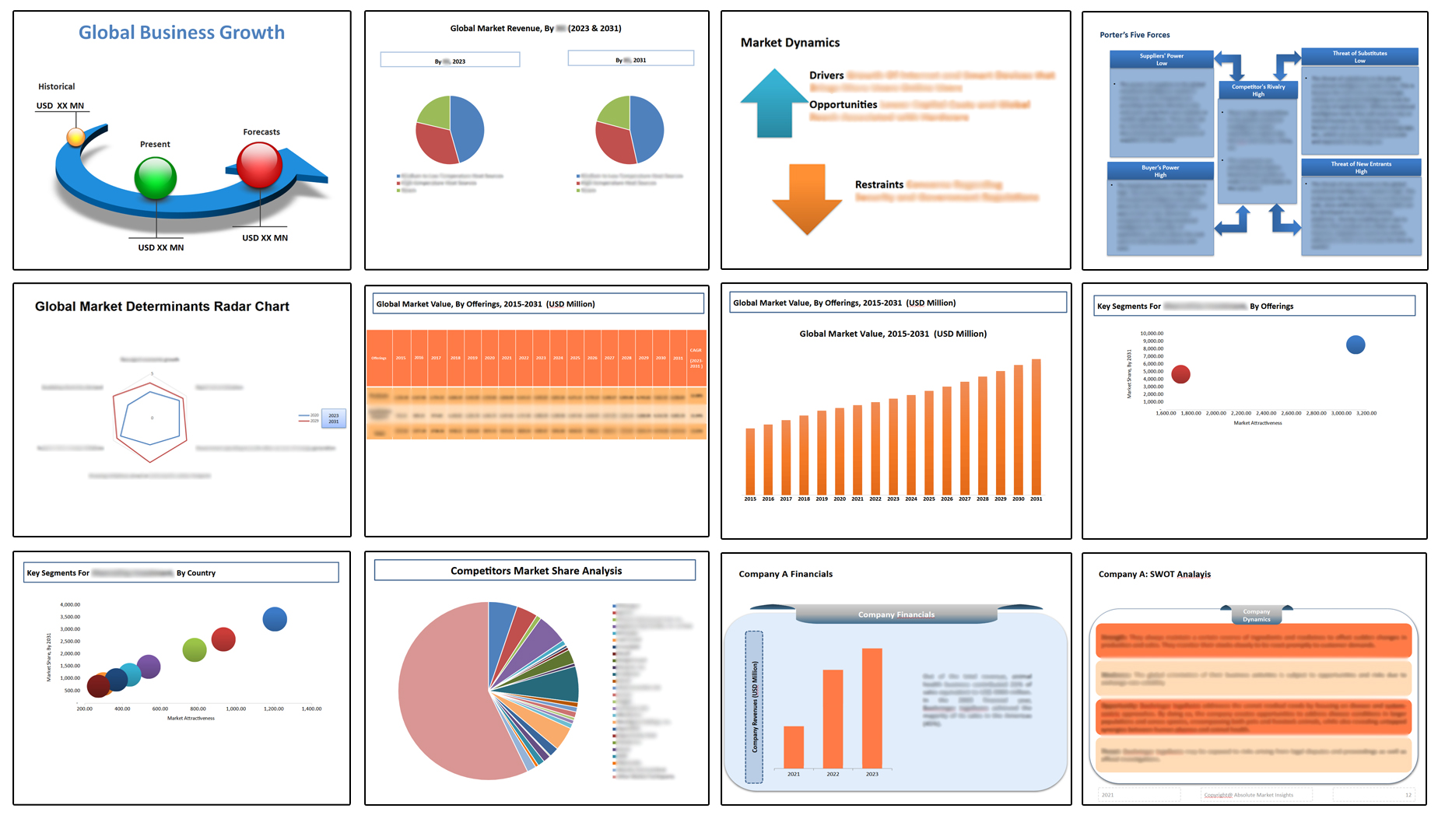
Table of Contents
Note: This ToC is tentative and can be changed according to the research study conducted during the course of report completion.
**Exclusive for Multi-User and Enterprise User.
Global AI in Epidemiology Market
By Deployment Mode
- Cloud
- On- Premises
By Application
- Disease Surveillance and Monitoring
- Outbreak Prediction and Forecasting
- Diagnostic Support and Imaging Analysis
- Drug Discovery and Development
- Personalized Medicine
- Healthcare Resource Allocation
- Others
By End User
- Hospitals and Clinics
- Diagnostic Centers
- Pharmaceutical and Biotechnology Companies
- Research Institutes and Academic Centers
- Others
By Region
- North America (U.S., Canada, Mexico, Rest of North America)
- Europe (France, The UK, Spain, Germany, Italy, Nordic Countries (Denmark, Finland, Iceland, Sweden, Norway), Benelux Union (Belgium, The Netherlands, Luxembourg), Rest of Europe)
- Asia Pacific (China, Japan, India, New Zealand, Australia, South Korea, Southeast Asia (Indonesia, Thailand, Malaysia, Singapore, Rest of Southeast Asia), Rest of Asia Pacific)
- Middle East & Africa (Saudi Arabia, UAE, Egypt, Kuwait, South Africa, Rest of Middle East & Africa)
- Latin America (Brazil, Argentina, Rest of Latin America)
The Niche Research approach encompasses both primary and secondary research methods to provide comprehensive insights. While primary research is the cornerstone of our studies, we also incorporate secondary research sources such as company annual reports, premium industry databases, press releases, industry journals, and white papers.
Within our primary research, we actively engage with various industry stakeholders, conducting paid interviews and surveys. Our meticulous analysis extends to every market participant in major countries, allowing us to thoroughly examine their portfolios, calculate market shares, and segment revenues.
Our data collection primarily focuses on individual countries within our research scope, enabling us to estimate regional market sizes. Typically, we employ a bottom-up approach, meticulously tracking trends in different countries. We analyze growth drivers, constraints, technological innovations, and opportunities for each country, ultimately arriving at regional figures.Our process begins by examining the growth prospects of each country. Building upon these insights, we project growth and trends for the entire region. Finally, we utilize our proprietary model to refine estimations and forecasts.
Our data validation standards are integral to ensuring the reliability and accuracy of our research findings. Here’s a breakdown of our data validation processes and the stakeholders we engage with during our primary research:
- Supply Side Analysis: We initiate a supply side analysis by directly contacting market participants, through telephonic interviews and questionnaires containing both open-ended and close-ended questions. We gather information on their portfolios, segment revenues, developments, and growth strategies.
- Demand Side Analysis: To gain insights into adoption trends and consumer preferences, we reach out to target customers and users (non-vendors). This information forms a vital part of the qualitative analysis section of our reports, covering market dynamics, adoption trends, consumer behavior, spending patterns, and other related aspects.
- Consultant Insights: We tap into the expertise of our partner consultants from around the world to obtain their unique viewpoints and perspectives. Their insights contribute to a well-rounded understanding of the markets under investigation.
- In-House Validation: To ensure data accuracy and reliability, we conduct cross-validation of data points and information through our in-house team of consultants and utilize advanced data modeling tools for thorough verification.
The forecasts we provide are based on a comprehensive assessment of various factors, including:
- Market Trends and Past Performance (Last Five Years): We accurately analyze market trends and performance data from preceding five years to identify historical patterns and understand the market’s evolution.
- Historical Performance and Growth of Market Participants: We assess the historical performance and growth trajectories of key market participants. This analysis provides insights into the competitive landscape and individual company strategies.
- Market Determinants Impact Analysis (Next Eight Years): We conduct a rigorous analysis of the factors that are projected to influence the market over the next eight years. This includes assessing both internal and external determinants that can shape market dynamics.
- Drivers and Challenges for the Forecast Period:Identify the factors expected to drive market growth during the forecast period, as well as the challenges that the industry may face. This analysis aids in deriving an accurate growth rate projection.
- New Acquisitions, Collaborations, or Partnerships: We keep a close watch on any new acquisitions, collaborations, or partnerships within the industry. These developments can have a significant impact on market dynamics and competitiveness.
- Macro and Micro Factors Analysis:A thorough examination of both macro-level factors (e.g., economic trends, regulatory changes) and micro-level factors (e.g., technological advancements, consumer preferences) that may influence the market during the forecast period.
- End-User Sentiment Analysis: To understand the market from the end-user perspective, we conduct sentiment analysis. This involves assessing the sentiment, preferences, and feedback of the end-users, which can provide valuable insights into market trends.
- Perspective of Primary Participants: Insights gathered directly from primary research participants play a crucial role in shaping our forecasts. Their perspectives and experiences provide valuable qualitative data.
- Year-on-Year Growth Trend: We utilize a year-on-year growth trend based on historical market growth and expected future trends. This helps in formulating our growth projections, aligning them with the market’s historical performance.
Research process adopted by TNR involves multiple stages, including data collection, validation, quality checks, and presentation. It’s crucial that the data and information we provide add value to your existing market understanding and expertise. We have also established partnerships with business consulting, research, and survey organizations across regions and globally to collaborate on regional analysis and data validation, ensuring the highest level of accuracy and reliability in our reports.









